
I have several karyotype activities where students construct karyotypes and diagnose a chromosome disorder, like Down Syndrome. Some of these were designed with flash, which is no longer useable, and some use paper models like this Chromosome study.
My newest karyotype lesson uses Google Slides and chromosomes that can be dragged and placed in the correct location on the grid. I usually assign this lesson after students lean about meiosis and focus on how chromosomes come in pairs. Students can also view the Chromosomes and Karyotypes video by the Amoeba Sisters.
Students are assigned one of four slides where they find the homologous pairs of chromosomes and drag them to the chart to arrange them by size. Each set shows a trisomy condition, where one of the pairs has an extra chromosome indicating one of three conditions: Down Syndrome, Patau Syndrome, and Edward Syndrome. Once the diagnosis has been made, students are asked to use Google to investigate what the long term prognosis is for the individual with the disorder.
By doing this manipulative, students gain a sense of how homologous chromosomes have similar banding patterns, sizes, and centromere location. They also gain an appreciation for chromosome numbers by seeing visually a complete diploid set for a typical human and how the last set is reserved for the sex chromosomes, X and Y.
If you are using this with younger kids, you may want to modify the investigation to include specific sites for students to research. This article from AboutKidsHealth is straightforward and avoids students finding potentially sensitive images from Google search.
Screenshot of the Assignment:

A design choice I made in this activity was shading the X and Y chromosomes so they are easy to find and identify. I found it extremely challenging to try to find and place the X chromosome which is as large as #1, and if the Y chromosome is present, students will struggle to find the match when it has none.
I want students to practice matching homologs and diagnosing diseases, but I don’t want this to be an exercise in frustration. This is also why I recommend only assigning one of the sets and not all four. One is enough for students to get a good sense of how karyotypes work. You can then share the other sets from other groups or even have volunteers share their work and diagnosis.
While I have done the cut and paste version in the past, I think going forward I will use this digital version even when we aren’t in a pandemic. It eliminates the time-consuming aspect of cutting out chromosomes and the hassle of students losing a chromosome in the process. Drag and drop for this activity is just a better design.

